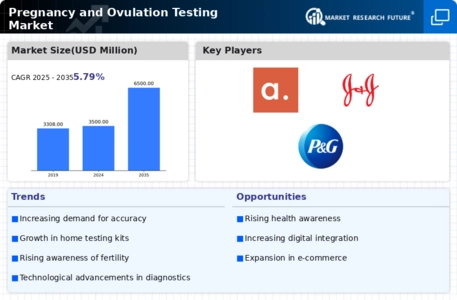Increasing Fertility Issues
The rising prevalence of fertility issues globally serves as a crucial driver for the Global Pregnancy and Ovulation Testing Market Industry. Factors such as lifestyle changes, environmental influences, and delayed childbearing contribute to infertility challenges. Consequently, there is a growing demand for ovulation testing products to assist individuals in understanding their fertility cycles. This trend is likely to propel the market forward, as more consumers seek solutions to enhance their chances of conception, thereby supporting the industry's growth trajectory.
Expansion of E-commerce Platforms
The expansion of e-commerce platforms plays a pivotal role in the Global Pregnancy and Ovulation Testing Market Industry. Online retailing provides consumers with convenient access to a wide range of testing products, often at competitive prices. The ease of purchasing these products online, coupled with discreet delivery options, encourages more individuals to engage with fertility testing. This trend is expected to contribute to the market's growth, as e-commerce continues to gain traction, particularly among younger demographics who prefer online shopping.
Government Initiatives and Support
Government initiatives aimed at promoting reproductive health and family planning significantly impact the Global Pregnancy and Ovulation Testing Market Industry. Various countries implement policies and programs to enhance access to reproductive health services, including testing products. These initiatives often include funding for educational campaigns and subsidized testing kits, which can increase market penetration. As governments recognize the importance of reproductive health, the industry is likely to benefit from increased support and resources, fostering a conducive environment for growth.
Rising Awareness of Reproductive Health
The increasing awareness surrounding reproductive health is a primary driver of the Global Pregnancy and Ovulation Testing Market Industry. Educational initiatives and campaigns by health organizations promote understanding of fertility and family planning, leading to a higher demand for testing products. As individuals become more informed about their reproductive health, the market is projected to reach 3500 USD Million in 2024. This heightened awareness encourages proactive health management, thereby fostering growth in the industry.
Technological Advancements in Testing Methods
Technological innovations in pregnancy and ovulation testing methods significantly influence the Global Pregnancy and Ovulation Testing Market Industry. The introduction of advanced testing kits, such as digital ovulation predictors and highly sensitive pregnancy tests, enhances accuracy and user experience. These innovations not only improve reliability but also cater to the growing preference for at-home testing solutions. As a result, the market is expected to expand, with projections indicating a growth to 6500 USD Million by 2035, reflecting the impact of technology on consumer choices.














Leave a Comment